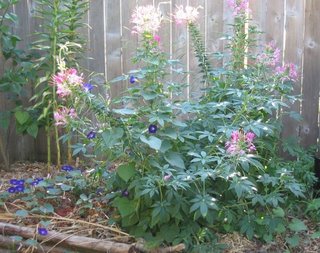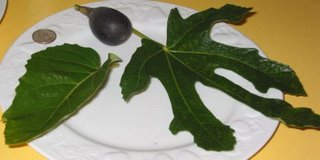
This is probably 'golden nugget' tomato, an open polinated Oregon variety which I grew for three years. It popped up in the rose bed. I didnt notice until I saw the yellow tomato.

This is probably 'gambo' pepper, an heirloom variety that I grew last year. It popped up in a flower pot along with some Italian Parsley; not much room left for the Euphorbia that was planted in the pot.

This is a morning glory that I grew last year. It looks very nice sprialling around the cleome. It's excessively exuberant - and there are others around the yard.
I remember the concept of 'volunteer' plants from growing up in Quincy. The volunteer is a seedling that sprouted, without human intervention, from seeds that fell or were otherwise distributed (such as seeds spread by birds, or a fruit pit abandoned after eating the fruit, or seeds that survived composting kitched scraps). Around the yard are volunteer Rose of Sharon, and semi-volunteer rose bushes (from discarded prunings that somehow survived and sprouted). These represent the tenacity of life, growing without effort from me or any other grower (such as commercial outfits). As such, they are treasures.
Unless they turn into weeds (like ivy, but that's another story).
Today's puttering:
1. I planted a seedling ginkgo, to replace the slowly dying Monkey Puzzle tree. Who knows whether there is something wrong with that yard location (in which case I might have doomed the ginkgo). I hope it's not Sudden Oak Death - but as slow as this tree has been dying (over three years), it's not sudden.
2. Cleaned up the strawberries. Removed old leaves. Pulled out crowded strawberries, and planted at the edge of the tomato bed and blueberry border.
3. Deadheaded roses.
4. Mowed the brown but weedy lawn. Maybe this will be the year to try an eco-lawn?
5. I think I'm going to pick some grapes now.













